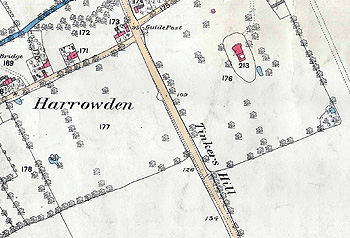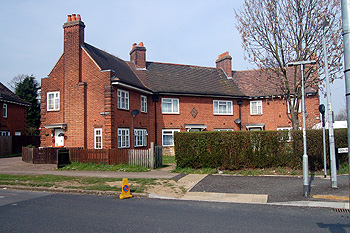The Development of Shortstown
The following article was written by Alan Cox and John Wood of Bedfordshire County Council’s Planning Department’s Conservation Section in 1983 [ref: CRT130Cardington34]

Tinkers Hill in 1883
The Early History of the Site
Shortstown is built on Tinkers Hill, Harrowden. Harrowden is mentioned in the Domesday Survey of 1086 when it appears as “Herghetone” or “Hergentone”. This comes from the Anglo-Saxon “hearg-dun”: “hearg” means a place of heathen worship with some form of sacred grove or shrine, while “dun” refers to the slight rise in the ground here. Thus, Shortstown may stand on the site of an ancient sacred shrine.
Subsequently a windmill stood on the site from the 13th century to the 16th century, and in the 17th and 18th centuries the area was known as Windmill Hill.
Origins of Shortstown
Early in 1916 the Admiralty was seeking s site for an airship works for Messrs. Short Brothers and after a two month search the Naval Director of Air Services reported in March 1916 that a site had been selected at Cardington:
(a) it was well served by roads and railways, and was in easy reach of London by steam train;
(b) it was, therefore, easy for the Admiralty to maintain close liaison with the factory;
(c) there was a broad, flat valley running east-west without any obstructions, thus providing a sufficient manoeuvring area to handle rigid airships;
(d) Cardington was beyond the range of then known German bombers in Belgium, while “penetration by submarine landed agents was not considered likely due to the distance from the coast which it would be necessary to travel”;
(e) there was suitable surplus labour available in Bedford;
(f) “the river affords a means of disposing of the effluent from sewage disposal works if such are established”.
The whole site was bought by the Admiralty from the Whitbread Estate for £110,000 and in October 1916 Short Brothers made proposals for housing the employees required at the airship works. They estimated that for 1917 they would require 800 workers, 500 men and 300 women – of which 200 (mainly women) they hoped to obtain in Bedford. The rest would be houses in an entirely new “Garden City” type settlement alongside the works.

Shortstown when newly built [ref: X766/1/50]
The Building of Shortstown
By June 1919 the first phase of 151 houses had been built. This consisted of 12 six-roomed houses, 39 five-roomed houses, 64 four-roomed houses and 36 flats of three rooms each. The general layout, and the design of the houses and airship works were by Cackett & Burns Dick, architects of Newcastle-upon-Tyne. Work was carried out by them under the control of the Director of Works, Admiralty, and no local contractors were used.
The houses in this initial development are in a simplified neo-Georgian style, mainly red brick with dark red tile roofs, and are more reminiscent of Hampstead Garden Suburb in London than the original Garden City at Letchworth. Although the road layout is fairly formal and most of the houses are terraced, regimentation is avoided by arranging groups of houses around curves in a butterfly pattern or by setting some houses back and some forward in a particular terrace.
Further houses were envisaged to the south and west but in the event these were not built until many years later, and then with little regard to the original style and layout. Similarly, the original plan made provision for shops, churches, a cinema and a hall in the centre but all that was built was a social club.

The hangars at RAF Cardington, March 2011
The Royal Airship Works
As a result of the building of Shortstown the population of Eastcotts rose from 848 in 1911 to 2,065 by 1921. However, in the meantime Short Brothers, who were experiencing various difficulties, withdrew from airship manufacture and the Cardington venture with effect from 1st April 1919 and moved to Rochester in Kent. The Cardington works was, therefore, taken over directly by the government and renamed the Royal Airship Works, but the associated settlement has retained its original name of Shortstown.
During the 1920s the giant airship R101 was built at Cardington, while its sister ship, the R100 was brought to Cardington in December 1929. The R101 set off for its maiden flight to India on the evening of 4th October 1930 but in the early hours of the next morning it crashed into a hillside at Beauvais in France, killing all but six of its fifty four crew and passengers. The shock of this tragedy brought an abrupt end to this phase of British airship manufacture and the R100 was broken up.

Houses at Shortstown, March 2011
RAF Cardington
The Royal Airship Works was put on a care and maintenance basis until 1938 when it was renamed the Balloon Development Establishment. However, the social club at Shortstown was still known as the Royal Airship Works and Shortstown Club in the 1980s.
In the meantime, in 1936, an RAF station had opened at Cardington, being particularly concerned with producing gas for barrage balloons and training barrage balloon crews as well as more general training of recruits and NCOs. Throughout the 1940s Cardington remained a busy RAF station and from 1953 it became the RAF’s main recruitment centre.
After the Second World War, further houses were built at Shortstown as married quarters for RAF personnel. The three avenues off the southern extension of Greycote are named after three prominent victims of the R101 disaster: Brigadier-General Lord Thomson of Cardington, Secretary of State for Air; Air Vice Marshal Sir W. Sefton Brancker, Director of Civil Aviation at the Air Ministry and Major George Herbert Scott, Assistant Director of Airship Development (Flying and Training) at the Royal Airship Works.
The roads of the western half of the site are all named after Second World War bomber aircraft. Finally in 1957 Shortstown got its own school.
With the ending of National Service and cuts in the armed forces the RAF’s presence at Cardington began to dwindle and largely disappeared in the 1970s. As a result the population of Eastcotts declined from 3,675 in 1951 to 1,710 in 1981.